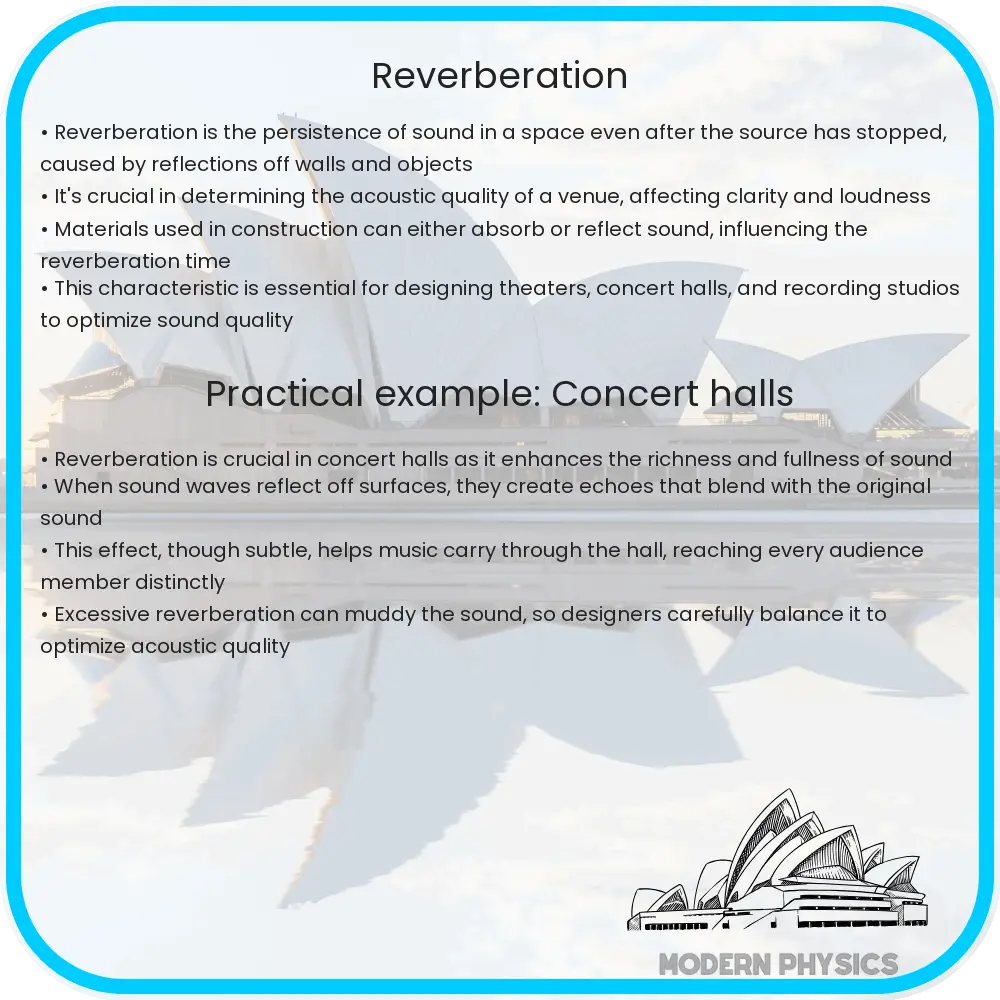Reverberation in acoustics refers to the persistence of sound in a space after the initial sound ceases, influenced by reflections from surfaces.

Understanding Reverberation in Acoustics
Reverberation is a fundamental concept in acoustics, describing the persistence of sound in a particular space after the original sound source has ceased. When a sound is made in a room, it can reflect off walls, ceilings, floors, and other surfaces before reaching the listener’s ears. The reflections cause the sound to sustain and gradually decay, creating what is known as reverberation.
What Causes Reverberation?
Reverberation is primarily caused by the reflection of sound waves. When a sound wave hits a surface, part of the energy is absorbed and part is reflected, depending on the material’s characteristics. Hard, smooth surfaces like concrete or tile will reflect more sound than they absorb, enhancing reverberation. Conversely, soft, porous materials like curtains or carpets absorb more sound, reducing reverberation.
Reverberation Time
Reverberation time (RT) is a key measure in acoustics and is defined as the time it takes for the sound to decay by 60 decibels from its initial level. It is typically measured in seconds and encompasses the entirety of the sound’s decay process. RT can be influenced by several factors, including the size and shape of the room, the types of surfaces present, and the volume and frequency of the original sound.
Calculating Reverberation Time
The most well-known formula for calculating reverberation time is the Sabine formula, named after Wallace Clement Sabine, an American physicist who pioneered architectural acoustics. The formula is expressed as:
RT = 0.161 * V / A
- V represents the volume of the room in cubic meters.
- A is the total absorption in the room, in sabins, which is a unit named after Sabine himself.
This formula assumes that the sound field is diffuse, meaning sound waves are traveling equally in all directions, which is generally a good approximation in typical rooms.
Impact of Reverberation on Clarity and Ambiance
The presence and extent of reverberation can significantly impact the acoustic clarity and overall ambiance of a space. In environments such as concert halls or theaters, a certain level of reverberation is desirable as it enriches sound and adds depth, making the music or performances more vibrant and fulfilling.
However, excessive reverberation can lead to a decrease in speech intelligibility, as it can cause the words to blur together, making it difficult for the listener to understand. This is particularly problematic in spaces such as classrooms or meeting rooms, where clear communication is essential.
Designing for Optimal Reverberation
Architects and acoustic engineers aim to design spaces with optimal reverberation times that match their intended use. This involves careful consideration of the room’s geometry, the materials used in construction, and how the space will be utilized. Balancing these elements can help achieve the desired acoustic environment, whether it’s enhancing sound quality for a performance hall or ensuring clarity of speech in a classroom.
Examples of Reverberation in Everyday Life
Reverberation occurs in many settings beyond theaters and music halls. For instance, high reverberation times in a bathroom, which often has many hard, reflective surfaces, can make even a simple conversation echo. In contrast, a library tends to have low reverberation, as it uses soft materials like carpeting and filled bookshelves that absorb sound, making it a quiet space suited for reading and study.
Technologies That Modify Reverberation
Modern technology has introduced various ways to control and modify reverberation in architectural spaces. Acoustic panels, diffusers, and bass traps are commonly used to manage sound reflections and absorb excessive reverberation in recording studios and home theaters. Additionally, electronic devices called digital reverberators can artificially create desired reverberation effects in various environments without physical modifications to the space.
Conclusion
Reverberation is an intriguing and complex phenomenon that significantly influences our auditory experiences in various environments. Understanding the factors that affect reverberation, like room size, surface materials, and the volume of sound, allows architects and designers to tailor spaces optimally for specific audio needs. While certain levels of reverberation can enrich sound in settings like concert halls, controlling it in places such as classrooms and offices is crucial for clear communication. As we continue to innovate with materials and technology, our ability to manipulate acoustic environments willenhance, thereby improving our interaction with sound in our everyday lives.
